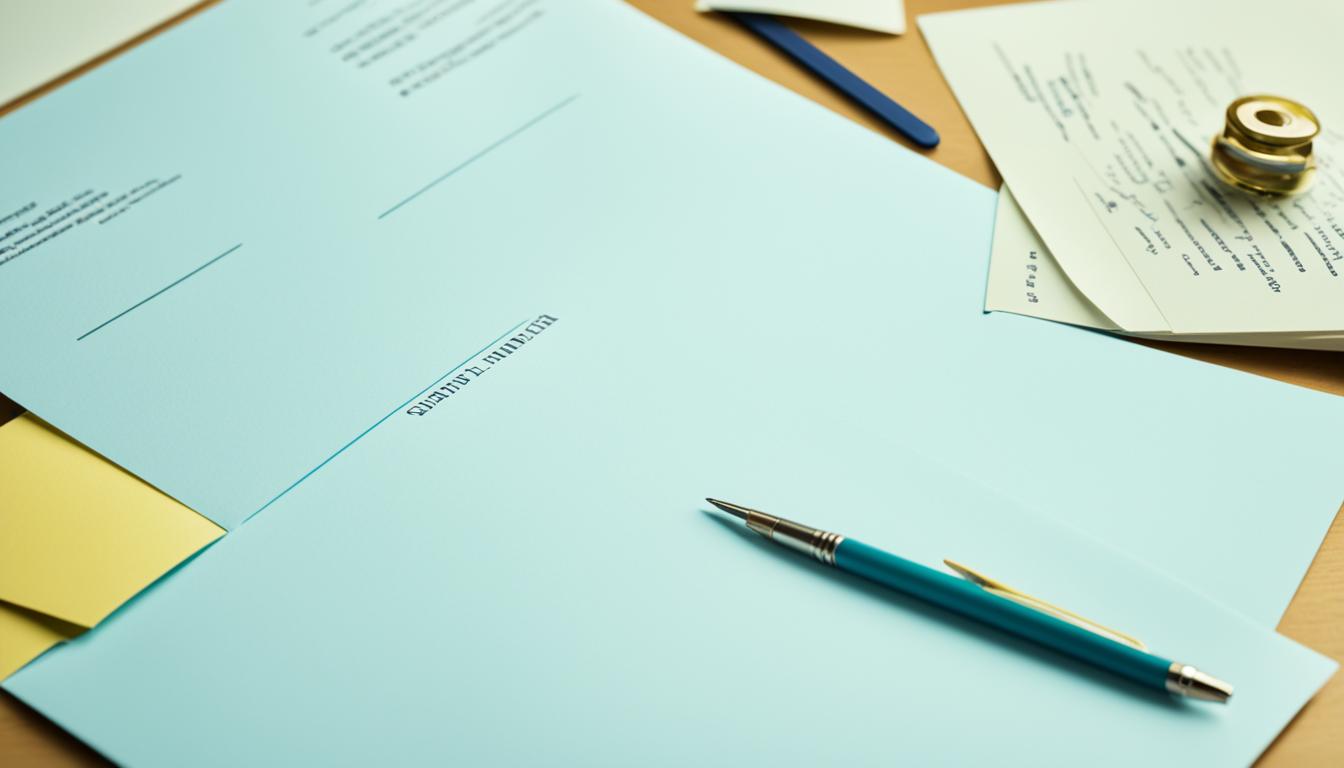Letter writing is an essential skill for effective communication, whether it’s for personal or professional purposes. In this article, we will provide you with a comprehensive guide on how to write a letter, covering formats, tips, and examples to help you master the art of letter writing.
Whether you’re writing a professional letter, sending a personal correspondence, or simply want to improve your writing skills for letters, this guide will provide you with the necessary tools and insights. From understanding the layout of a formal letter to crafting a well-composed message, we’ll take you through the step-by-step process of composing a letter that leaves a lasting impression.
With our tips for effective letter writing, you’ll learn how to convey your thoughts and ideas clearly and persuasively. From the composition of a formal letter to the nuances of writing a business letter, we’ll cover all the essential aspects to ensure your message is professional and impactful.
Stay tuned for our guide to writing a letter, where you’ll find expert advice, practical examples, and useful resources to help you become a master communicator through the written word.
Importance of Letter Writing
Writing a letter is still a valuable form of communication in today’s digital age. It allows you to convey your thoughts and ideas more effectively, make a lasting impression, and demonstrate your attention to detail. Whether it’s a formal business letter or a personal message, letter writing shows that you took the time to craft a thoughtful and meaningful message.
When it comes to effective communication, letter writing holds numerous benefits. Firstly, it provides a tangible record of your thoughts and intentions. Unlike emails or text messages that can easily be deleted or forgotten, letters can be physically kept and revisited, enhancing the significance of the message.
Moreover, personal correspondence through letters allows for a deeper level of connection. In a world dominated by instant messaging and social media, the gesture of receiving a heartfelt letter can evoke strong emotions and strengthen personal relationships. It conveys a sense of effort and sincerity that cannot be replicated through digital communication.
Letter writing is also crucial in professional settings. When applying for a job or pursuing business opportunities, a well-crafted and professional letter can set you apart from the competition. It shows that you possess effective communication skills, attention to detail, and a level of professionalism that is highly regarded in the business world.
Furthermore, letters offer the opportunity for reflection and thoughtful expression. Unlike a phone call or face-to-face conversation, writing allows you to carefully consider your words, choose the appropriate tone, and articulate your message with clarity and precision. This aspect of letter writing allows for effective communication, especially when discussing complex or sensitive matters.
Overall, letter writing remains an invaluable skill that can enrich both personal and professional communication. It allows you to express yourself more effectively, leave a lasting impression, and build stronger connections. So, the next time you have something important to say, consider picking up a pen and paper, and let the power of letter writing enhance your message.
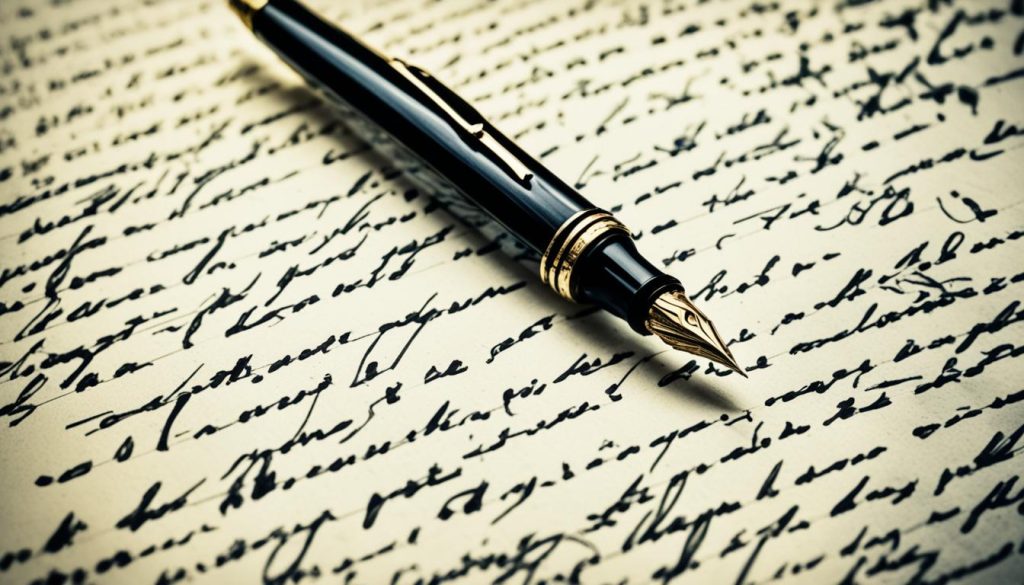
| Benefits of Letter Writing | Effective Communication | Personal Correspondence | Professional Correspondence |
|---|---|---|---|
| Provides a tangible record of thoughts and intentions | Demonstrates attention to detail | Deepens personal relationships | Sets you apart in professional settings |
| Evokes strong emotions and strengthens connections | Allows for thoughtful reflection and expression | Enhances sincerity and effort in communication | Facilitates effective communication in complex matters |
Choosing the Right Format for Your Letter
Before starting your letter, it’s important to determine the appropriate format based on the purpose and audience. For formal letters, you can choose between block style and AMS style, both of which have specific guidelines for formatting and organization. On the other hand, informal letters provide more flexibility in terms of structure and tone.
Formal Letter Formats
Formal letters require a structured format to maintain professionalism and convey information effectively. The two commonly used formats are:
| Block Style Format | AMS Style Format |
|---|---|
| The entire letter is aligned to the left margin, including the sender’s address, date, recipient’s address, salutation, body paragraphs, complimentary close, and signature. | The content is aligned in a specific AMS-based format, consisting of alternating left- and right-justified sections. |
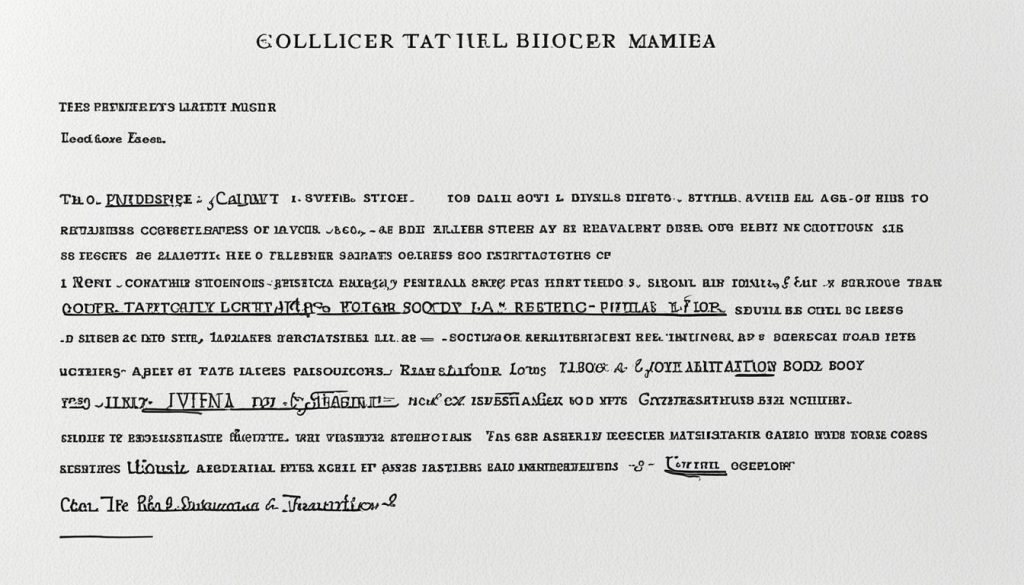 |
Informal Letter Format
Informal letters provide a more relaxed and casual tone suitable for personal communication. The format for informal letters is less rigid and allows for greater personalization. Some key features of the informal letter format include:
- No specific alignment requirements.
- A casual salutation, such as “Dear [Recipient’s Name],” or a friendly greeting.
- A conversational tone throughout the letter.
- Flexibility in paragraph formatting.
When deciding on the format for your letter, consider the tone, purpose, and audience to ensure an appropriate and effective communication style.
How to Write a Letter?
Formal letters play a crucial role in maintaining clarity and professionalism. To ensure your formal letter is well-structured and conveys your message effectively, it should include the following key elements:
- Contact Information: Provide your full name, address, phone number, and email address at the top of the letter. This allows the recipient to easily reach you if necessary.
- Date: Include the date on which you are writing the letter. This helps establish a timeline and provides context for the recipient.
- Salutation: Begin your letter with a formal salutation, such as “Dear [Recipient’s Name],” or “To whom it may concern,” depending on the level of familiarity with the recipient.
- Body of the Letter: The main content of your letter should be well-structured and organized into paragraphs. Each paragraph should have a clear purpose and be separated by a blank line for readability.
- Complimentary Close: Conclude your letter with a formal closing, such as “Yours sincerely,” or “Kind regards,” followed by your name.
- Signature: Sign your name directly below the complimentary close. If the letter is printed, you can leave space to physically sign your name.
- Enclosure: If you are including additional documents or materials with your letter, mention them at the end of the letter. For example, you can write “Enclosure: Curriculum Vitae” or “Enclosures: Invoice and Receipt.”
To provide a visual representation of the key elements of a formal letter, refer to the table below:
| Element | Description |
|---|---|
| Contact Information | Sender’s full name, address, phone number, and email address |
| Date | Date on which the letter is written |
| Salutation | Formal greeting to address the recipient |
| Body of the Letter | Main content of the letter, organized into paragraphs |
| Complimentary Close | Formal closing to end the letter |
| Signature | Sender’s signature or printed name |
| Enclosure | Mention of additional documents or materials enclosed with the letter |
By incorporating these key elements into your formal letter, you can ensure a professional and effective communication that leaves a lasting impression.
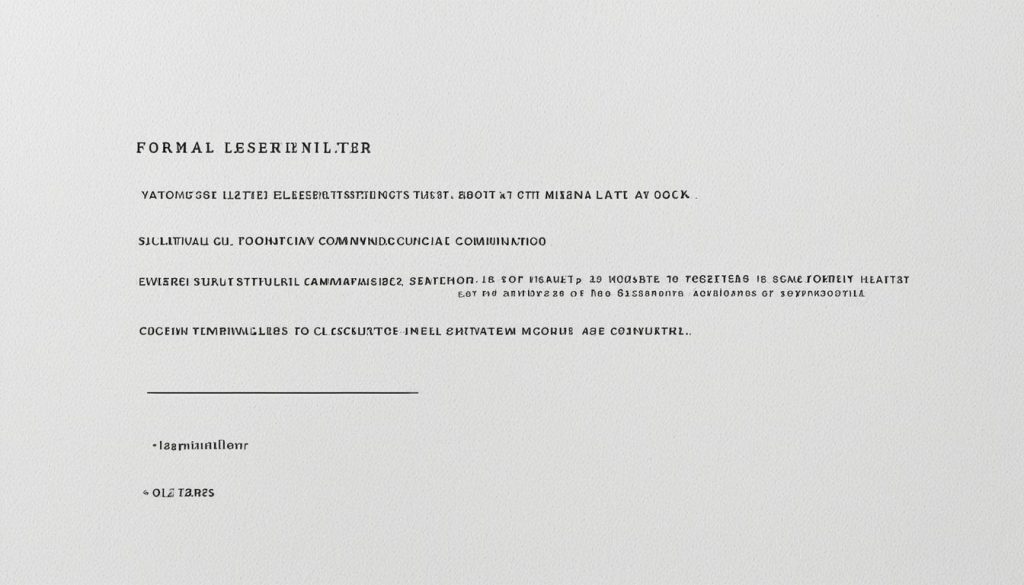
Tips for Writing an Informal Letter
Informal letters provide an opportunity to take a more relaxed and conversational approach to communication. Whether you’re writing a personal letter to a friend or a casual message to a colleague, here are some helpful tips to keep in mind:
- Friendly Tone: Maintain a friendly and warm tone throughout your letter. Use language that reflects your relationship with the recipient and creates a sense of familiarity.
- Casual Greeting: Begin your letter with a casual greeting, such as “Dear [Recipient’s Name],” to establish a comfortable and informal atmosphere.
- Clear and Concise Language: Keep your language clear, concise, and easy to understand. Avoid using complex vocabulary or lengthy sentences.
To demonstrate these tips in action, consider the following example of an informal letter:
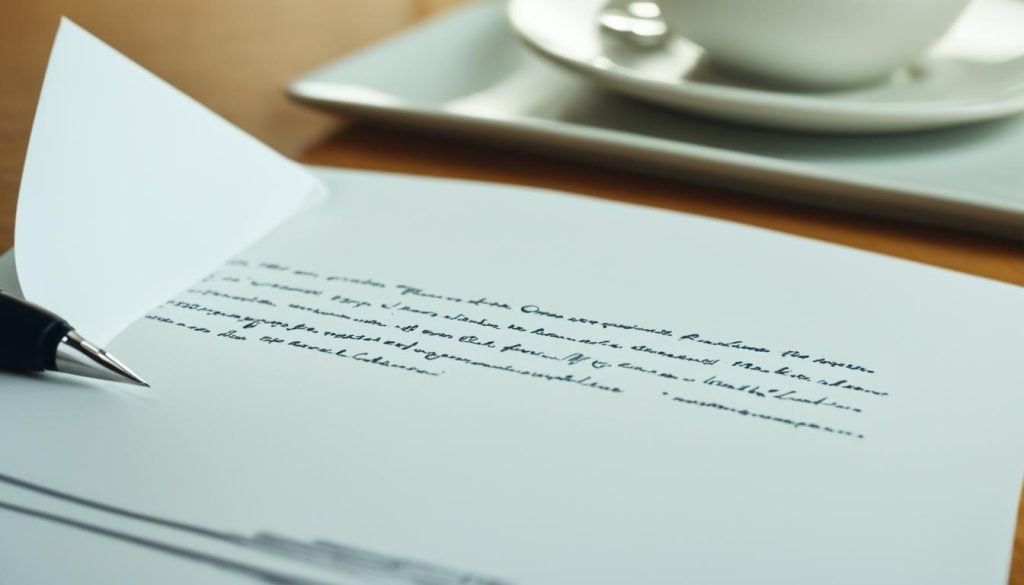
| Dear Emma, |
|---|
| I hope this letter finds you well. It’s been a while since we last caught up, and I wanted to reach out and see how you’re doing. |
| The reason I’m writing is to invite you to my birthday party next week. I’m hosting a small gathering with a few close friends, and I would be thrilled if you could join us. |
| Please let me know if you’re available on the 15th of September. We’ll be celebrating at my place, and it would be fantastic to have you there. We can catch up, reminisce about old times, and have a great time together. |
| I really value our friendship, Emma, and I would love to have the opportunity to spend some quality time with you. Let’s make this birthday celebration one to remember! |
| Looking forward to hearing from you soon. |
| Take care and see you soon! |
| Warm regards, |
| Emily |
Organizing and Structuring Your Letter
When writing a letter, it is essential to ensure that your message is clear, organized, and easy to understand. To achieve this, follow these effective strategies:
1. Define Your Main Message
Start by identifying the main message or purpose of your letter. This will serve as the foundation for your entire communication. Be concise and make sure your main message is easily discernible.
2. Provide an Overview Sentence
Include an overview sentence that succinctly outlines the content of your letter. This provides the reader with a clear understanding of what to expect and helps them navigate through your message.
3. Organize Paragraphs Coherently
Structure your letter with well-organized paragraphs that flow logically from one to the next. Each paragraph should focus on a specific point or topic and contribute to the overall message of your letter.
4. Use Headings as Signposts
Incorporate headings to guide the reader through the different sections of your letter. Headings make it easier for the reader to find specific information and allow for better overall comprehension.
5. Engage the Reader with Pronouns
Make your letter more personal and engaging by using pronouns such as “you” and “we.” This creates a sense of direct conversation and establishes a stronger connection with the reader.
By following these techniques, you can ensure that your letter is well-structured, organized, and effectively conveys your main message. Take the time to plan and structure your letter to optimize communication and achieve your desired outcomes.
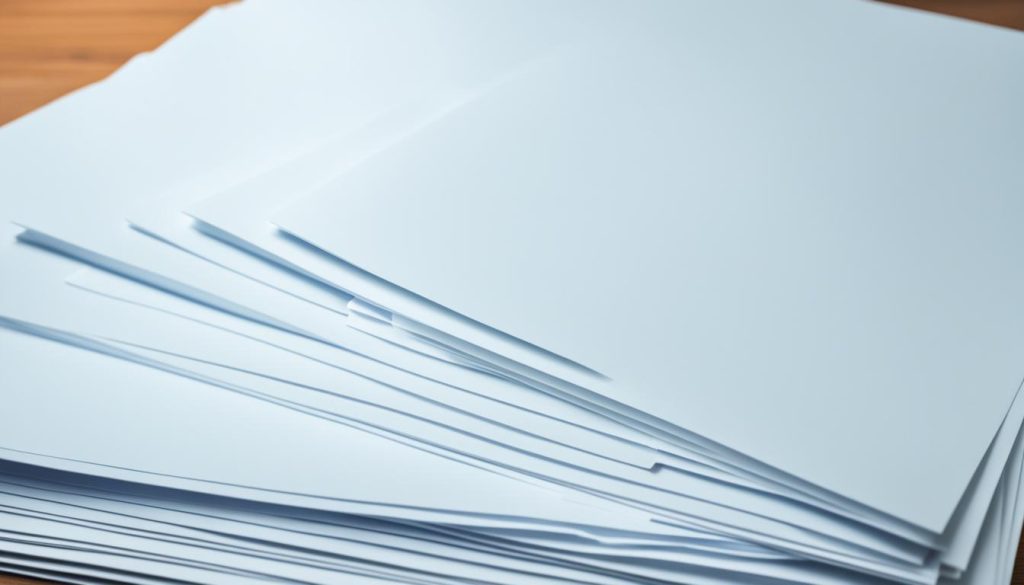
Example: Organizing and Structuring Your Letter
| Section | Content |
|---|---|
| Main Message | Clearly state the purpose or main message of your letter. |
| Overview Sentence | Provide a concise summary of the letter’s content. |
| Paragraph Organization | Structure your letter with coherent paragraphs that flow logically. |
| Headings | Use headings to guide the reader and make information easily accessible. |
| Pronouns | Engage the reader by using pronouns to create a personal connection. |
Crafting an Effective Conclusion
The conclusion of your letter is your last opportunity to leave a lasting impression. It is vital to summarize the main points discussed in the body of the letter, restate any key information, and provide a clear call to action if necessary. By crafting a compelling conclusion, you can ensure that your message resonates with the reader and achieves its intended purpose.
Recap Main Points
Start your conclusion by briefly recapping the main points addressed in the body of the letter. This serves as a helpful reminder for the reader and reinforces the key ideas you want to emphasize. By summarizing the main points, you can ensure that your letter’s message is concise and impactful.
Call to Action
If applicable, incorporate a clear call to action in your conclusion. This encourages the reader to take the desired next step after reading your letter. Whether it’s requesting a meeting, submitting documentation, or following up on previous correspondence, a well-crafted call to action adds purpose and direction to your letter.
Final Thoughts and Closing Remarks
Use the conclusion of your letter to share final thoughts and closing remarks. This is an opportunity to reiterate your appreciation, express optimism, or highlight any additional information you want to leave with the reader. A strong and positive closing sets the tone for future interactions and leaves a memorable impression.
In conclusion, crafting an effective conclusion is essential when writing a letter. It allows you to recap the main points, provide a clear call to action, and leave the reader with final thoughts and closing remarks. By implementing these strategies, you can ensure that your letter communicates your message effectively and leaves a lasting impact on the recipient.
Conclusion
The art of letter writing is a skill that, when mastered, can greatly enhance your communication abilities and have a positive impact on your personal and professional relationships. By following the tips and guidelines provided in this article, you can confidently write various types of letters, whether formal or informal, and effectively convey your message to your intended audience.
Writing a well-crafted letter allows you to demonstrate your attention to detail, showcase your thoughtfulness, and make a lasting impression. It provides you with the opportunity to connect with others in a more personal and meaningful way, regardless of the digital age we live in. Effective communication skills are essential in today’s fast-paced world, and mastering letter writing is a valuable tool that can set you apart.
Remember to structure your letters appropriately by choosing the right format, including the key elements of a formal letter, and using a friendly and engaging tone for informal letters. Organize your thoughts and ideas in a logical manner, and conclude your letters with a strong closing that summarizes the main points and leaves a favorable impression on the reader.
In summary, by honing your letter writing skills, you can become an effective communicator and effectively convey your message, whether for personal or professional purposes. Embrace the art of letter writing and experience the power it holds in connecting with others.

